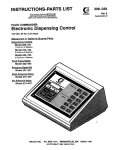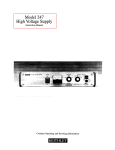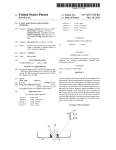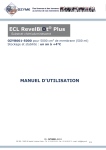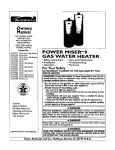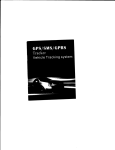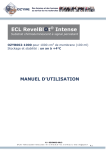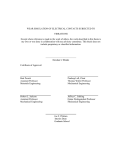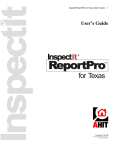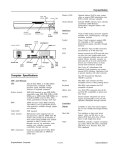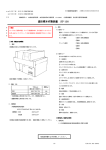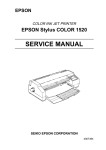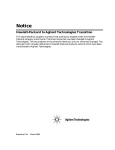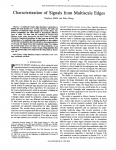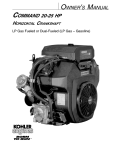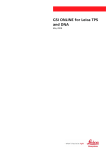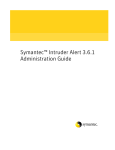Download Keithley -
Transcript
Model 7076General Dual 4 x 12 Instruction Manual Contains Operating Publication Document Date: April 1991 Number: 7076-901-01 Purpose Matrix and Servicing Rev. B Information Card WARRANTY Keithley Instruments, Inc. warrants this product to be free from defects in material and workmanship for a period of 1 year from date of shipment. Keithley Instruments, Inc. warrants the following items for 90 days from the date of shipment: probes, cables, rechargeable batteries, diskettes, and documentation. During the warranty period, we will, at our option, either repair or replace any product that prows to be defective To exercise this warranty, write or call your local Keithley representative, or contact Keithley headquarters in Cleveland, Ohio. You will be given prompt assistance and return instructions. Send the product, transportation prepaid, to the indicated service facility. Repairs will be made and the product returned, transportation prepaid. Repaired or replaced products are warranted for the balance of the original warranty period, or at least 90 days. LIMITATION OF WARRANTY This warranty does not apply to defects resulting from product modification without Keithley’s express written consent, or misuse of any product ot’ part. This warranty also does not apply to fuses, software. non-rechargeable batteries, damage from battery leakage, or problems arising from normal wear or failure to follow instructions. THIS WARRANTY IS IN LIEU OF ALL OTHER WARRANTIES, EXPRESSED OR IMPLIED, INCLUDING ANY IMPLIED WARRANTY OF MERCHANTABILITY OR FITNESS FOR A PARTICULAR USE. THE REMEDIES PROVIDED HEREIN ARE BUYER’S SOLE AND EXCLUSIVE REMEDIES. NEITHER KEITHLEY INSTRUMENTS, INC. NOR ANY OF ITS EMPLOYEES SHALL BE LIABLE FOR ANY DIRECT, INDIRECT, SPECIAL, INCIDENTAL OR CONSEQUENTIAL DAMAGES ARISING OUT OF THE USE OF ITS INSTRUMENTS AND SOFTWARE EVEN IF KEITHLEY INSTRUMENTS, INC., HAS BEEN ADVISED IN ADVANCE OF THE POSSIBILITY OF SUCH DAMAGES. SUCH EXCLUDED DAMAGES SHALL INCLUDE, BUT ARE NOT LIMITED TO: COSTS OF REMOVAL AND INSTALLATION, LOSSES SUSTAINED AS THE RESULT OF INJURY TO ANY PERSON, OR DAMAGE TO PROPERTY. Keithley Instruments, Inc. * 28775 Aurora Road * Cleveland, OH 44139 - 216-248-0400 -Fax: 216-248-6168 - http://www.keithley.com General Purpose Matrix Card Dual 4 x 12 Model 7076 Instruction Manual 01990, Keithley Instruments, Inc. All rights reserved. Cleveland, Ohio, U. S. A. Document Number: 7076-901-01 All Keithley product names are trademarks or registered trademarks of Keithky Instruments, Inc. Other brand and product names are trademarks or registered trademarks of their respective holders SAFETY PRECAUTIONS The following safety precautions should be observed before using the Model 7076 and the associated instruments. This matrix card is intended for use by qualified personnel who recognize shock hazards and are familiar with the safety precautions required to avoid possible injury. Read over this manual carefully before using the matrix card. ALWAYS remove power from the entire system (Model 707, test instruments, before doing any of the following: 1. Installing or removing DUT, etc.) and discharge any capacitors the matrix card from the mainframe. 2. Connecting or disconnecting cables from the matrix card. The pins of cable connectors are easily accessible making them extremely hazardous to handle while power is applied. 3. Making internal changes to the card (such as removing or installing jumpers). Exercise extreme caution when a shock hazard is present at the test f?xture. User-supplied lethal voltages may be present on the tlxture or the connector jacks. The American National Standards Institute (ANSI) states that a shock hazard exists when voltage levels greater than 30V RMS or42.4V peak are present. A good safety practice is to expect that hazardous voltage is present in any unknown circuit before measuring. Do not connect the card or any other instrumentation to humans. Inspect the connecting cables and test leads for possible wear, cracks, or breaks before each use. For maximum under test. safety, do not touch the test fixture, test cables or any instruments while power is applied to the circuit Do not touch any object which could provide a current path to the common side of the circuit under test or power line (earth) ground. Do not exceed the maximum manual. signal levels of the test fixture, as defined in the specifications and operation section of this Do not connect the matrix card directly to unlimited power circuits. This product is intended to be used with impedance limited sources. NEVER connect the matrix card directly to ac mains. When connecting sources, install protective The chassis connections connections. devices to limit fault current and voltage to the card. must only be used as shield connections for measuring circuits, NOT as safety earth ground Model 7076 Dual 4x12 Two-Pole Matrix Card MATRIXCON”GURATION:Dual4rowsby12columns.Alsocanfigurableas8rowsby 12 mhmns. Jumpers can be removed to isolate any row from the backplane. CROSSPOINT CONFIGURATION: 2 pole Form A (HI, GUARD). CONNECTOR TYPE: 25.pin subminiature D connector, two for column connection, one far row connection. MAXIMUM SIGNAL LEVEL: DC Signals: IIOV DC, IA switched, 30VA ksistive load). AC Signals: 175” AC peak, IA switched, 62SVA (resistive load). COMMON MODE VOLTAGE: IIOV DC, 175V AC peak pin to pi” or pi” to chassi% CONTACT LIFE: Cold Switching: 10s closures. At M.Mm”rn Signal Level: 105 closures. PATH RESISTANCE (per conductorb <0.5On initial, <1.5R at end of contact life CONTACTPOTENTIAL: <5pV per crosspaint (HI lo GUARD). OFFSET CURRENT: <lOOpA. ISOLATION: PatlIz >lOw2, <7PF. Differential: >lOQ l2opF nominal. Common Mode: >lOQ 2OOpFnominal. CROSSTALK (IMHr, Mfi 1o;db <-5OdB. INSERTION LOSS (IMHz, 5On source, 5OR load): 0.05dB typical. 3dB BANDWIDTH (500 load): 15MHz typical. RELAY DRIVE CURRENT (per crosspoint): 28mA. RELAY SE’ITLING TIME: <3ms. ENVIRONMENT: Operating: 0’ to 5O”C, up to 35°C at 70% R.H. storage: -250 to WC. ACCESSORY SUPPLIED: instruction manual, jumpers for 8 x 12 expansion. 5pcifications subject to change without notice. Column Jumpers - (user Table of Contents SECTION 1.1 1.2 1.3 1.4 1.5 1.6 1.7 1.7.1 1.7.2 1.7.3 1.8 1.9 1- INTRODUCTION FEATURES . WARRANTY INFORMATION MANUAL ADDENDA SAFETY SYMBOLS AND TERMS SPECIFICATIONS . . UNPACKING AND INSPECTION Inspection for Damage . . . Shipping Contents Instruction Manual REPACKING FOR SHIPMENT OPTIONAL ACCESSORIES SECTION 2.1 2.2 2.3 2.4 2.4.1 2.4.2 2.5 2.5.1 2.5.2 2.5.3 2.5.4 2.6 2.6.1 2.6.2 2.7 2.7.1 2.7.2 2.7.3 2.7.4 2.7.5 2.8 2.8.1 2.8.2 2.8.3 2.8.4 2.9 2- 1-l l-1 1-l 1-l 1-l 1-l 1-l 1-l l-2 l-2 l-2 l-2 Operation ....................................... INTRODUCTION .............................. HANDLING PRECAUTIONS .................... CARD INSTALLATION AND REMOVAL ........................ BASIC MATRIX CONFIGURATIONS ......................................... 4x24Matrix 8xl2Matrix ......................................... TYPICAL MATRIX SWITCHING SCHEMES .................. ................................ Single-ended Switching. Differential Switching .................................. Guarding ........................................... Sensing ............................................. CONNECTIONS ....................................... Standard Cable (Model 7075-MTC) ........................ High Isolation Cables (Model 7076-RMTC and Model 707&CMTC) MATRIXEXPANSION. .................................. Backplane Row Jumpers ................................ Narrow Matrix Expansion ............................... Wide Matrix Expansion ................................. ........................... Partial Matrix Implementation ............................ Mainframe Matrix Expansion T(PICAL CONNECTION SCHEMES ........................ .................................... Single Card System Multiple Card System .................................. Multiple Mainframe System ............................. Matrix/Multiplexer System .............................. ........................... BANDWIDTH and CROSSTALK SECTION 3 3.1 3.2 3.2.1 General Information 2-l 2-l 2-l 2-2 2-6 2-7 2-8 2-8 2-8 2-9 2-9 2-10 2-11 2-13 2-15 2-15 2-17 2-18 2-19 2-19 2-20 2-20 2-21 2-21 2-22 2-25 Applications INTRODUCTION .............................................................. ....................................... THICK FILM RESISTOR NETWORK TESTING .............................................. Four-terminal Ohms Measurements 3-1 3-l 3-3 3.2.2 3.3 3.3.1 3.3.2 .................................................... VoltageDividerChecks TRANSISTOR TESTING .................................................... Current Gain Checks ...................................................... .................................................. Is and Vm Measurements SECTION 4.1 4.2 4.3 4.4 4.4.1 4.4.2 4.4.3 4.4.4 4.4.5 4.4.6 4.4.7 4.4.8 4.5 4.5.1 4.5.2 4.5.3 4.6 4.7 4.7.1 4.7.2 5- 3-4 3-6 3-6 3-8 Service Information ................................ INTRODUCTION ........ HANDLING AND CLEANING PRECAUTIONS RELAY TEST PROGRAM SET-UP ................... PERFORMANCE VERIFICATION ................... ....................... Environmental Conditions ....................... Recommended Equipment ........................ Matrix Card Connections Path Resistance Tests ........................... Offset Current Tests ............................ Contact Potential Tests .......................... Path Isolation Tests ............................. Differential and Common Mode Isolation Tests ........ IWNCIPLES OF OPERATION ...................... ............................. Card Identification Switching Circuitry ............................. Power Up Safeguard ............................ SPECIAL HANDLING OF STATIC-SENSITIVE DEVICES ............................ TROUBLESHOOTING ....................... Recommended Equipment Troubleshooting Procedure ....................... SECTION 5.1 5.2 5.3 5.4 5.5 4- . Replaceable ............. ............. ............. ............. ............. ............. ............. ............. ............. ............. ............. ............. ............. ............. . ............. ............. ............. ............. ............. ............. . 4-l 4-l 4-l 4-2 4-2 4-3 4-3 4-3 4-4 4-6 4-7 4-9 4-12 4-12 4-12 4-12 4-13 4-13 4-13 4-13 Parts .......................................................... INTRODUCTION PARTSLIST .............................................................. ................................................. ORDERING INFORMATION ........................................................ FACTORYSERVICE COMPONENT LAYOUT AND SCHEMATIC DIAGRAM ............................ 5-l 5-l 5-l 5-l 5-l List of Illustrations SECTION Figure Figure Figure Figure Figure Figure Figure Figure Figure Figure Figure Figure Figure Figure Figure Figure Figure Figure Figure Figure Figure Figure Figure Figure Figure 2- Matrix Card Installation .......................................... Model7076 .................................................... Simplified Component Layout ..................................... Model 7076 Configured as4 x 24 Matrix .............................. .............................. Model7076Configuredas8x12Matrix ....................................... Column Jumper Installation Single-ended Switching Example (Using 7075-MTC Cable) ................ Differential Switching Example (Using High Isolation Cables) .............. Driven Guard Example (Using High Isolation Cables) .................... Sensing Example (Using High Isolation Cables) ......................... D-sub Receptacle Contact Assignments ............................... Model 7075-MTC Standard Cable ................................... D-sub Plug Pin Assignments for High Isolation Cables ................... Schematic Drawing of Backplane Jumper Configuration (Factory Default) ..... Narrow Matrix Example (4 x 72) .................................... ................. Dual4x72Matrices ............................ ........................... . .......... WideMatrixExample(8x36) Partial Matrix Expansion (8 x 36) .................................... Single Card System Example ....................................... Multiple Card System Example ..................................... Multiple Mainframe Example ...................................... Matrix/Multiplexer System ....................................... -3dB Bandwidth (Crosspoint Al closed, Rs = RL = 5OQ) ................... -3db Bandwidth (Crosspoint HI2 closed, RS= RRL= 500) ................. Crosstalk (Crosspoints Gl and H2 closed, 5OQ source on ROW G, 500 load on COLUMN l’, Measurements at ROW H) .............................. Crosstalk (Cross oints All and 812 closed, 5On source on ROW A, 5OQ load on COLUMN 11, Mpeasurements at ROW B) .............................. 2-l 2-2 2-3 24 2-5 2-6 2-7 2-8 2-9 2-10 2-11 2-12 2-13 2-14 2-15 2-16 2-17 2-18 2-19 2-20 2-21 2-22 2-23 2-24 2-25 Figure 2-26 SECTION Figure Figure Figure Figure Figure Figure Figure Figure 3-l 3-2 3-3 34 35 3-6 3-7 3-8 Operation 3- . 2-3 24 2-5 2-6 2-7 2-8 2-8 2-8 2-9 2-9 2-10 2-12 2-14 2-16 2-17 2-18 2-18 2-20 2-21 2-22 2-23 2-24 2-25 2-25 2-26 2-26 Applications Thick Film Resistor Network Testing 4-Terminal Ohms Measurements Voltage Divider Checks . . Transistor Testing . . . Transistor Current Gain Checks . Common Emitter Characteristics of an NPN Silicon Transistor . Transistor IE Measurements Transistor VsEMeasurements ......... ......... ......... ......... ......... ......... ......... ......... 3-2 3-3 3-5 3-6 3-7 3-8 3-9 3-10 SECTION 4 Figure Figure Figure Figure Figure Figure Figure Figure Figure Figure 4-l 4-2 4-3 4-4 4-5 4-6 4-7 4-8 4-9 4-10 Service Information Relay Test Setup . . ....... Path Resistance Testing . . . . .. ... Common Mode Offset Current Testing Differential Mode Offset Current Testing Contact Potential Testing . Path Isolation Testing (Guarded) Differential Isolation Testing .. . Common Mode Isolation Testing . . . ID Data Timing Diagram D-sub Receptacle Contact Assignments . ................. ................. ................. ................. ................. ................. ................. ................. ................. ................. 4-2 44 4-5 4-6 4-7 4-8 4-11 4-11 4-12 4-14 List of Tables SECTION 2 Table Table Table Table Table Table Table Table 2-1 2-2 2-3 24 2-5 2-6 2-7 2-8 SECTION 4 Table Table Table Table Table 4-l 4-2 4-3 44 4-5 Operation Column Number Assignments 4 x 24 Matrix Crosspoint Assignments . .. . Available Cables and Connectors Cable Conductor Identification (Model 7075-MTC) Model 7076.RMTC Conductor Identification Model 7076~CMTC Conductor Identification . Narrow Matrix Expansion* . . . Wide Matrix Expansion’ . .............. .............. .............. .............. .............. .............. .............. .............. 2-3 2-7 2-11 2-13 2-15 2-15 2-17 2-19 Service Information Verification Equipment ................................ Path Isolation Tests ................................... Differential and Common Mode Isolation Test .............. ................ Recommended Troubleshooting Equipment ............................ Troubleshooting Summary” .................... .................... .................... .................... .................... 4-3 4-9 4-10 4-13 4-14 SECTION 1 General Information 1 .l INTRODUCTION This section contains general information about the Model 7076 General Purpose Matrix Card Dual 4 x 12. 1.2 1.5 SAFETY SYMBOLS AND TERMS The following symbols and terms may be found on an instrument or used in this manual. Then symbol on an instrument indicates that the user should refer to the operating instructions located in the instruction manual. FEATURES The Model 7076 is a general purpose, two-pole, dual 4 x 12 (four row by 12 column) matrix card. Some of the key feahxes include: Guard capability. Each HI path on the PC board is surrounded by a second path that can be used for guarding. l Low contact potential and offset current for minimal effects on low-level signals. . Quick disconnects using 2.5pin D-Sub connectors on the rear panel. . Row backplane jumpers. Cutting jumpers disconnects rows from the Model 707 backplane. l Column jumpers. Installing jumpers configures card as an 8 x 12 matrix. l 1.3 WARRANTY MANUAL The WARNING heading used in this manual explains dangers that might result in personal injury or death. Always read the associated information very carefully before performing the indicated procedure. The CAUTION heading used in this manual explains hazards that could damage the matrixcard. Such damage may invalidate the warranty. INFORMATION Warranty information is located on the inside front cover of this instruction manual. Should your Model 7076 require warranty service, contact the Keithley representative or authorized repair facility in your area for further information. When returning the matrix card for repair, be sure to fill out and include the service form at the back of this manual in order to provide the repair facility with the necessary information. 1.4 The f symbol on an instrument shows that high voltage may be present on the terminal(s). Use standard safety precautions to avoid personal contact with these voltages. ADDENDA Any improvements or changes concerning the matrix card or manual will be explained in an addendum included with the unit. Be sure to note these changes and incorporate them into the manual. The terms COLUMN, COLUMNS, ROW and ROWS are used in this manual as a reference to the rear panel receptacles of the matrix card. 1.6 SPECIFICATIONS Model 7076 specifications may be found at the front of this manual. These specifications are exclusive of the matrix mainframe specifications. 1.7 1.7.1 UNPACKING Inspection AND INSPECTION for Damage The Model 7076 is packaged in a re-sealable, anti-static bag to protect it from damage due to static discharge and l-l SECTION 1 General Information from contamination that could degrade its performance. Before removing the card from the bag, observe the following precautions on handling. Handling Precautions: 1. Always grasp the card by the handle and side edges. Do not touch the edge connectors and do not touch board surfaces or components. 2. When not installed in a Model 707 mainframe, keep the card in the anti-static bag and store in the original packing carton. 1.8 If you are going to install the card in the Model 707 mainframe at this time, be sure to follow the additional handling precautions explained in paragraph 2.2. 1.7.2 Shipping The following order: l l l l Contents items are included with every Model 7076 Model 7076 Dual 4 x 12 Two-pole Matrix Card. Column jumper sets. Model 7076 Instruction Manual. Additionalaccessoriesasordered.Note that thecables may be shipped in a separate packing carton. 1.7.3 Instruction Manual The Model 7076 Instruction Manual is three-hole drilled so that it can be added to the three-ring binder of the Model 707 Switching Matrix Instruction Manual. After removing the plastic wrapping, place the manual in the binderafterthemainframeinstructionmanual.Notethat a manual identification tab is included and should precede the matrix card instruction manual. If an additional instruction manual is required, order the manual package, Keithley part number 7076-901-00. The manual package includes an instruction manual and any applicable addenda. l-2 FOR SHIPMENT Should it become necessary to return the Model 7076 for repair, carefully pack the unit in its original packing carton or the equivalent, and include the following information: l l l Advise as to the warranty status of the matrix card. Write ATTENTION REPAIR DEPARTMENT on the shipping label. Filloutandincludetheserviceformlocatedat theback of this manual. 1.9 Afterremovingthecard fromitsanti-staticbag,inspectit for any obvious signs of physical damage. Report any such damage to the shipping agent immediately. REPACKING OPTIONAL The following Model 7076: ACCESSORIES accessories are available Model 7075-MTC Assembly Standard RowlCohmn for use with the Cable The Model 707S-MTC is a three-meter (IO-feet), 24 conductor cable terminated with a 25-pin D-subminiature (D-sub) connector on both ends. This cable connects to either the ROWS or COLUMN receptacles on the rear panel of the card. This cable assembly is constructed using a general purpose flat cable that is fitted into a shielded round jacket. Thiscable iscommonly cut at a convenient length to provide two separate cables. The cables can then be used to connect to both the ROW and COLUMN receptacles. The unterminated ends of the cables can then be connected to instrumentation and DUTs. Model 7076-RMTC HighIsolationRow CableAssembly The Model 707GRMTC is a three meter (IO-feet), 2%conductor cable terminated with a 25pin D-sub connectors onbothendsandisconfigured tomatetotheROWreceptacle of the Model 7076. Each conductor pair (signal and drain) of the shielded cable is wrapped with insulated foil to minimize crosstalk between conductor pairs. This cable is commonly cut at a convenient length to provide two separate cables. The cables can then be used to connect to both COLUMN receptacles. The unterminated ends of the cables can then be connected to instrumentation and DUTs. SECTION 1 General Model 7076-Ch4TC High isolation Assembly Column Cable The Model 7076-CMTC is a 3-meter (lo-feet), 28-conductor cable terminated with a 25-pin D-sub connector on both ends. This cable connects to either one of the two COLUMN receptacles on the Model 7076. Each conductor pair (signal and drain) of the shielded cable is wrapped with insulated tween conductor pairs. foil to minimize Information crosstalk be- This cable is commonly cut at a convenient length to provide two separate cables. The cables can then be used to connect to both COLUMN receptacles. The unterminated ends of the cables can then be connected to instrumentation and DUTs. 1-3 SECTION 2 Operation 2.1 INTRODUCTION WARNING The matrix configuration procedures in this section should only be performed by qualified personnel who recognize shock hazards and are familiar with the safety precautions required to avoid possible injury. Review the safety precautions found at the front of this manual. This section contains information on aspects of matrix card operation and is arranged as follows: 2.2 To avoid possible contamination, always grasp the card by the handle and side edges. Do not touch the edge connectors of the card and do not touch board surfaces or components. On D-subminiature (D-sub) connectors, do not touch areas adjacent to the electrical contacts. CAUTION Do not store the card by leaning it against an object (such as B wall) with its edge connectars in contact with a contaminated surface (such as the flood. The edge connectors will become contaminated, and tapes and solder connections on the PC board may break as the card bends. ALWAYS store the card (in its anti-static bag) in the original shipping carton. lMiOIl. 2.3 Card Installation and Removal: Covers the basic procedure for installing and removing the card from the Model 707 Switching Matrix. 2.5 Typical Matrix Switching Schemes: Explains some of the basic ways that a matrix can be used to source or measure. Covers single-ended switching, differential (floating) switching, sensing, shielding, and guarding. 2.6 Connections: JXxwses the various methods and techniques that can be used to connect DUTs and in&umentation to the matrix card. PRECAUTIONS To maintain high impedance isolation, care should be taken when handling the matrix card to avoid contamination from such foreign materials as body oils. Such contamination can substantially lower leakage resistances, degrading performance. 2.2 Handling Precautions: Details precautions that should be observed when handling the matrix card to ensure that its performance is not degraded due to contami- 2.4 Basic Matrix Configurations: Covers the basic matrix configurations that the card can be configured for; dual 4 x 12 matrices, a single 4 x 24 matrix or a single 8 x 12 matrix. HANDLING Dirt build-up over a period of time is another possible source of contamination. To avoid this problem, operate the mainframe and matrix card in a clean environment. If the card becomes contaminated, it should be tboroughly cleaned as explained in paragraph 4.2. 2.3 CARD INSTALLATION AND REMOVAL 2.7 Matrix Expansion: Discusses the various matrix configurations that are possible by using multiple cards. The significance of backplane row jumpers on matrix configurations is also covered here. WARNING To avoid electrical shock that could result in injury or death, ALWAYS remove power from the entire system (Model 707, test instruments, DUT, etc.) and discharge any capacitors before doing any of the following: 2.8 Typical Connection Schemes: Provides examples of external connections for single card, multiple card and multiple mainframe systems. 1. Installing or removing from the mainframe. the matrix card 2-1 SECTION 2 operation 2. Connecting or disconnecting cables from the matrix card. The pins of the cable connectors are easily accessible making them extremely hazardous to handle while power is applied. 3. Making internal changes to the card (such as removing or installing jumpers). Cable connections to the matrix card make it difficult to install or remove the card from the mainframe. Thus, it is advisable to install the card and then make cable connections to it. Conversely, cables should be disconnected before removing the card from the mainframe. Referring to Figure 2-1, perform the following procedure to install the Model 7076 matrix card in the Model 707: CAUTION Contamination will degrade the performance of the matrix card. To avoid contamination, always grasp the card by the handle and side edges. Do not touch the edge connectors of the card, and do not touch the board SUP faces or components. On connectors, do not touch areas adjacent to the electrical contacts. Turn the Model 707 off. Select a slot in the mainframe and remove the coverplate. The cover-plate is fastened to the mainframe chassis with two screws. Retain the cover-plate and screws for future use. With the relay side of the matrix card facing towards the fan, feed the card into the slot such that the top and bottom card edges seat into the card edge guides of the mainframe. Slide the matrix card all the way into the mainframe and tighten the two spring loaded panel fasteners. WARNING The mounting screws must be secured to ensure a proper chassis ground connection between the card and the mainframe. Failure to properly secure this ground connection may result in personal injury or death due to electric shock. 2-2 4. To remove the card from the mainframe make sure the Model 707 is off, power is removed from external circuitry, and then reverse the above procedure. 2.4 BASIC MATRIX CONFIGURATIONS A simplified schematic of the Model 7076 matrix card is shown in Figure 2-2A. As shipped from the factory, the matrix card is configured as two separate 4 x 12 matrices. Each of the 96 crosspoints is made up of a two-pole switch. By closing the appropriate crosspoint switch, any matrix row can be connected to any column in the same matrix. In this manual, the columns of every Model 7076 matrixcard arereferred to as columns 1 through 12 and 1’ through 12’. Columns 1 through 12 correspond to the columns receptacle (on the connection panel) labeled “TO ROWS A-D”, while references to columns 1’ through 12 correspond to the columns receptacle labeled “TO ROWS E-H”. Note that even though there are 24 unique columns in this configuration, the Model 707 recognizes only 12 columns for programming purposes. The crosspoint assignments for the matrix card are provided in Figure Z-28. For example, to connect r6w A to column 10, the Model 707 would have to be programmed to close crosspoint A10 (row A, column 10); and to connect row E to column 10’ (22nd column), crosspoint El0 would have to be closed. These crosspoint closures assume that the matrix card is installed in slot 1 of the mainframe. The crosspoint assignments in Figure 2-2B are valid regardless of how the card is configured. The column number assignments for programming the Model 707 are determined by the mainframe slot that the matrixcard is installed in. For example, the column number assignments of a matrix card installed in slot 4 of the mainframe are numbered 37 through 48. Column number assignments for all six mainframe slots are listed in Table 2-1. Notice in Figure 2-2A that there are backplane jumpers located on the matrix card. With the jumpers installed, the matrix card is connected to the backplane of the Model 707 allowing matrix expansion (see paragraph 2.7). With the jumpers removed, the matrix card is isolated from any other cards installed in the mainframe. The physical location of these jumpers on the board is shown in Figure 2-3. SECTION 2 Operation Mounting Screws Card Handle Figure 2-1. Matrix Card Installation Table 2-l. Column 1 7076 Card Location Slot Slot Slot Slot Slot Slot 1 2 3 4 5 6 1 Number Matrix Assignments Column 1 through 13 through 25 through 37 through 49 through 61 through Numbers 12 24 36 48 60 72 2-3 SECTION 2 r----- _------------ --- 1 A. Simplified Schematic r---- ‘igure 2-2. 2-4 Model 7076 -------------- 1 SECTION 2 Oaeration I 1 I 0 I I I l 0 . Cigure 2-3. SimpIified Component layout 2.4.1 4 x 24 Matrix Removing the backplane jumpers will isolate the 4 x 24 matrix from any other card installed in the mainframe. Figure 2-4 shows how the Model 7076 can be configured as a single 4 x 24 matrix. Row jumper wires are used to connect rows A, B, C and D to rows E, F, G and H respectively. These connections can be made wherever it is most convenient, such as at the connector of a customized cable ass$mbly, or at the instrumentation (see Figure Z-15) or DUT test fixture. In a multiple left installed, Crosspoint assignments for progmmming the Model 707 do not change even though the matrix configuration of the card has changed (see Figure 2-28). For example, to connectrowAtothe24th(12’)columnofthe4x24matrix (see the equivalent circuit in Figure 2-4), the Model 707 would have to be programmed to close crosspoint El2 kmmingtbecardisinstaUedinslot 1 of themainframe). Table 2-2 provides the crosspoint assignments for a Mode17076 configuredasa4x24matrixinstalled inslot 1 of the mainframe. Table2-I provides the column number assignments for the other mainframe slots. card system where badcplane jumpers are row jumpers are only required at one card. r--------------------~ Fmv J”rnpers \ Column II I I I 1 2 3 4 5 6 TTTTTTTTI 7 8 I II/~ Backplane Jumpers I I II I I I I Column I Equivalent Circuit ‘igure 2-4. 2-6 Model 7076 Configuredas 4 x 24Matri.r SECTION 2 Operation Table 2-2. M.&X Row* 1 A(E) B(F) C(G) D(H) Al Bl Cl Dl Crosspoint Assignments Matrix Column r---- 2.4.2 4 x 24 Matrix 2 3 A2 B2 A3 c2 E D3 D2 . .. ::: 12 1’ 2’ 3’ A12 B12 El Fl E2 F2 E3 Cl2 Gl D12 Hl ----------------_ Column 8 x 12 Matrix Figure 2-5 shows that the Model 7076 can be configured asastandard8~12matibyinstallingtbecolumnjumpem. The location of the column jumpers on the PC-board is shown in Figure 2-3. As shipped from the factory, the 12columnjumperssetsarenotinstalled. Installingthe E . .. 12’ El2 F12 ::: E H3 G12 H12 1 jumpers sets, as shown in Figure 2-6, configures Model 7076 as an 8 x 12 matrix. the With the Model 7076 backplane jumpers installed, the 8 x 12 matrix is connected to the backplane of the Model 707 allowing matrix expansion (see paragraph 2.7). With the backplane jumpers removed, the 8 x 12 matrix will be isolated from any other card installed in the mainframe. 2-7 SECTION 2 Operation 2.5.1 COI 1 Single-ended Switching Cal 1 Jumpers H . . In the single-ended switching configuration, the source or measure instrument is connected to the DUT through a single pathway as shown in Figure 2-7. Note that the shield of the Model 7075~MTC cable is connected to the shield around the DUT. . . Not Installed (as shipped) Note : See Fig. 2-3 for location of jumpers on Pcboard. ?gure 2-6. 2.5 2.5.2 Column Jumper Installation Differential Switching The differential or floating switching configuration is shown in Figure 2-8. The advantage of using this configuration is that the terminals of the source or measure inslmment are not confined to the same matrix crosspoint. Each terminal of the instrument can be connected to any matrix crosspoint. The guard terminals of the matrix card are used as a shield. TYPICAL MATRIX SWITCHING SCHEMES The following paragraphs describe some basic switching schemes that are possible with a two-pole switching matrix. 1 Shield Source or Measure Figure 2-7. L---l 7076 Single-ended Switching Example (Using 707.5MTC Cable) A ‘igure 2-8. 2-8 Diflerential Switching Example (Using High Isolation Cables) Earth Ground SECTION 2 0pL?Mi0?l 2.5.3 Guarding 2.5.4 Figure 2-9 shows how the matrix card can be used with a driven guard. Since the driven guard is at virtually the .same potential as signal high, protection from possible hazardous voltages (up to 175V peak) must be provided. Many instruments have the capability of configuring their input or output such that a driven guard is placed on the inner shield of a triax connector. The outer shield, connected to system common, provides protection from the guard voltage. When making connections from the matrix card to the DUT, a safety shield may be required, depending on the type of connectors used. Sensing Figure Z-100 shows how the matrix card can be configured to use instruments that have sensing capability. The main advantage of using sensing is to cancel the effects of matrix card path resistance (4.5) and the resistance of external cabling. Whenever path resistance is a consideration, sensing should be used. The standard cable (Model 7075-I&K) can also be used, however the high (H) paths in the cable will not be SWrounded by guard (G). 4 h 7076 Driven Guard Example (Using High Isolation Cables) Source or MWSWS 7076 Figure Z-10. Sensing Example (Using High Isolation Cables) System Common Earth Ground SECTION 2 Operation 2.6 Pin identification for the D-sub receptacles is provided in Figure 2-11. Adjacent to the each contact designation of the D-sub receptacles is the corresponding row or column that it is internally connected to. CONNECTIONS CAUTION To prevent damage (not covered by the warranty) and a possible safety hazard, do not exceed the maximum allowable limits of the Model 7076. Maximum signal levels are located at the listed in the specifications Cable Connections front of the manual. As shipped, all rows and columns of the Model 7076 matrix card are connected to the three 25-pin D-sub receptacles mounted on the rear panel of the matrix card. One receptacle is provided for row connections and two receptacles are provided for column connections. The COLUMNS receptacle located near the top is for rows A through D, while the other COLUMNS receptacle is for rows E through H. There are two basic cable types available to make connections to the matrix card; the standard cable (Model 7075~MTC), and high isolation cables (Model 7076~RMTC and Model 7076-CMK). Basically, the standard cable is a general purpose cable that will mate to either the ROWS or COLUMN receptacles. The high isolation cables provide better isolation between paths. The Model 7076-RMTC is used to connect to the ROWS receptacle, while the Model 707~CMTC is used to connect to the COLUMN receptacles. The available cables, as well as some miscellaneous connectors for customized user supplied terminations, are N/C N/C Row A Gd Cd 1 Gd Cd 1 HI Row A HI Row A Gd Cd 2 Gd Col2HI Row B Gd Row B HI Cd 3 Gd Cd 3 HI Cd 4 Gd Columns (A W Row 6 Gd Row C Gd Co14 HI Row C HI Row C Gd Cd 5 Gd Co15 HI ROW D Gd Row D HI Cd 6 Gd Co16 HI Row D Gd Row E Gd Cd 7 Gd Co17 HI Row E HI Row E Gd Cd 6 Gd Co16 HI Row F Gd Row F HI Cd 9 Gd Co19 HI CollOGd Col 10 HI Columns (E H) Row F Gd Row G Gd Row G HI Row G Gd Co111 Gd Col 11 HI Co112 Gd View of receptacles looking at Rear Panel Row H Gd Row H HI Cd 12 HI A) COLUMNS Receptacle (1 of 2) ‘igure Z-11. 2-10 D-sub Receptacle Contact Assigments Row H Gd HI = High Gd = Guard N/C = No connection B) ROWS Receptacle SECTION 2 Ckmntion Table 2-3. Available Manufacturer Model or Part Number Keithley Model 7075.MTC Standard Cable Keithley Model 7076.CMTC High Isolation Columns Cable Keithley Model 7076-RMTC High Isolation Rows Cable Keithley cs400 Keithley C%Ol Keithley Belden G-590 9868 82257000 3357-9225 Cables and Connectors Description Standard three-meter (10 feet) cable assembly terminated with 25-pin D-sub plugs on both ends. Mates to either the ROWS or COLUMN receptacles of the matrix card. Three-meter (10 feet), high isolation (for high isolation) cable assembly terminated with 25-pin D-sub plugs on both ends. Use to mate to either COLUMNS receptacle of the matrix card. Three-meter (10 feet), high isolation (for high isolation) cable assembly terminated with 25-pin D-sub plugs on both ends. Use to mate to the ROWS receptacle of the matrix card. 25-pin D-sub plug that will mate to the ROWS and COLUMN receptacles of the matrix card. Solder-cup connections simplify the building of custom cables. 25-contact D-sub receptacle that will mate to cables terminated with a 25-pin D-sub plug. Plastic backshell housing for CS400. High isolation cable. Same cable used for the Models 7076-RMTC and 707tXMTC cable assemblies. See paragraph 2.6.2 for description. 25-pin D-sub plug for customized ribbon cable assemblies. Junction shell for 3M 8225-7000 D-sub plug. summarized in Table 2-3. The cables available from Keithley are described in more detail in paragraphs 2.6.1 and 2.6.2. The same basic procedure applies for connecting ble plug to a test fixture receptacle. 2.6.1 WARNING To avoid electrical shock that could result in injury or death, ALWAYS remove power from the entire system (Model 707, test instruments, DUT, etc.) and discharge any capacitors before connecting or disconnecting cables from the matrix card. The pins of the cable connectors are easily accessible making them extremely hazardous to handle while power is applied. Use the following procedure to connect a cable terminated with a 25-pin D-sub plug to the matrix card: 1. Install thematrixcardin theModel707mainframeas explained in paragraph 2.3. 2. Push the plug of the cable onto the appropriate receptacle of the matrix card. The cable plug and matrix card receptacle will only mate one way. 3. Tighten the screws of the plug housing to secure it to the panel. Standard the ca- Cable (Model 7075-MTC) The standard cable (Model 7075-MT0 is a three-meter (10 feet), general purpose 24-conductor, shielded cable that is terminated with a Z-pin D-sub male plug on each end thatwillconnect toeither theROWSorCOLLJMNreceptacles on the matrix card. The standard cable (shown in Figure 2-12) is comprised of a flat ribbon cable that is located inside a shielded, round cable casing. The braided shield of the cable surrounds the ribbon cable and is subsequently connected to chassis ground when the cable is connected to a Model 7076 that is installed in a Model 707 mainframe. Pin designations on the D-sub plugs of the standard cable correspond to the contact designations on the D-sub receptacles of the matrix card. Thus, if connecting the standard cable to a COLUMNS receptacle, refer to Figure 2-1lA for column identification. If connecting the standard cable to the ROWS receptacle, refer to Figure 2-1lB for row identification. 2-11 SECTION 2 2CConductor Flat Ribbon Cable (located inside shielded round cable casing) . 11 . .z4IX . IO . 9 a 7 6 5 4 3 2 21 20 19 18 17 16 15 14 13 12 11 10 9 8 7 6 5 4 3 2 1 (Red Tracer) - 23 22 . . 21 . 20 . . . 19 . . 18 . 17 . . . 16 . . 15 . . 1 . 14 . I I_‘------------L 4I D-Sub Plug I ‘igure 2-12. Model 7075MTC the Standard Cable A common way to use the standard cable is to cut it at a convenient length. The result is two cables that are untertiated at one end. The flat ribbon cables at the unterminated ends of the cables can then be connected to in- 2-12 . ' '. 10 9 a 7 6 5 4 3 2 . 24 23 . .22 . . . . . . 21 20 Note : View from mating end of plug 19 . . . . . 1 l - D-Sub plug 4 L Braided shield surrounds ribbon cable. Standard Cable To connect the mati to instrumentation and DUT, a test fixture using a D-sub receptacle can beused to mate to the D-sub plug of the cable. The Keithley part number for the D-sub receptacle is listed in Table 2-3. Modifying ::* 25 strumentation and DUT, while the other ends will mate to the ROWS and COLUMN receptacles of the matrix card. The conductor designations of the ribbon cable are shown in Figure Z-12. The red tracer identifies conductor #I of the ribbon cable. Table 2-4 is provided to correspend the ribbon cable conductors to the matrix card row or column terminal. For example, if the standard cable is connected to the ROWS receptacle, ribbon cable conductor #24 will correspond to Row A Guard of the matrix card. Jf the cable was instead connected to the COLUMNS receptacle, ribbon cable conductor #24 will corre spend to Column 1 Guard of the matrix card. SECTION 2 Operation Table 2-4. Ribbon Cable Zonductor I* 2 3 4 5 6 i 9 10 11 12 13 14 15 16 17 18 19 20 li Ei *Conductor 2.6.2 Cable Conductor Identification (Model 7075-MTC) Matrix Row/Column Terminal Connected to Connected to ROWS COLUMNS Receptacle Receptacle ROW H, Guard ROW H, HI ROW H, Guard ROW G, Guard ROW G, HI ROW G, Guard ROW F, Guard ROW F, IU ROW F. Guard ROWE; Guard ROWE, HI ROW E, Guard ROW D, Guard ROW D, HI ROW D, Guard ROW C, Guard ROW C, HI ROW C, Guard ROW 0, Guard ROW B, Hl ROW 0, Guard ROW A, Guard ROW A, HI ROW A, Guard COLUMN COLUMN COLUMN COLUMN COLUMN COLUMN COLUMN COLLJMN COLUMN COLUMN COLUMN COLUMN COLUMN COLUMN COLUMN COLUMN COLUMN COLUMN COLUMN COLUMN COLUMN COLUMN COLUMN COLUMN #I of the ribbon cable is identified 12, HI 12, Guard 11, HI 11, Guard 10, HI 10, Guard 9, HI 9, Guard 8. HI 8; Guard 7, HI 7, Guard 6, HI 6, Guard 5, HI 5, Guard 4, HI 4, Guard 3, HI 3, Guard 2, HI 2, Guard 1, HI 1, Guard by the red tracer. High Isolation Cables (Model 7076~RMTC and Model 7076~CMTC) Shielded high isolation cables (Model 707~RMTC and Model 707~CMTC) are available to optimize performance by minimizing crosstalk between signal paths. Each HI signal path in the cable is completely surrounded by Guard (insulated foil) to maximize the effects of guarding. The outer foil shield of the cable is connected to the housings of the D-sub plugs. This shield is connected to chassis ground when the cable is connected to a Model 7076 that is properly installed in the Model 707 mainframe. The Model 707~RMTC is a 3meter (10 feet) 28-conductar cable terminated with a D-sub plug on each end. The plug pin assignment for this cable is configured to mate with the ROWS receptacle of the matrix card. Pin identification for this cable is shown in Figure 2-13A. The Model 7076~CMTC is a 3-meter (10 feet) 2&conductor cable terminated with a D-Sub plug on each end. The plug pin assignment for this cable is configured to mate with either of the two COLUMN receptacles of the matrix card. Pin identification for this cable is shown in Figure 2-138. For connections to instrumentation and DUT, a test fixture using a D-sub receptacles can be used to mate to the D-sub plugs of the cables. The Keitbley part number for the D-sub receptacle is listed in Table 2-3. Modifying the High Isolation Cable Another way to use the Model 7076-RMTC or Model 7076CMTC is to cut the cable at asuitable length and add appropriate user teqnination. Each cable can then be mated to the matrix card while the unterminated ends can be wired to another connector or directly to instmmentation and DUT. Each cable contains 12 conductor pairs each of which corresponds to a row or column. Each pair contains a colorcoded insulated wire (HI), and a bare drain wire (Guard). Each pair is wrapped in an insulated, color-coded foil which is also connected to Guard. The color combination of the HI conductor insulator and the surrounding foil is used for identification. Table 2-5 identifies the conductors of the Model 7076XMTC cable, while Table 2-6 provides identjfication for the Model 7076~CMTC cable. Note that for both cables, the black with red foil and white with blue foil pairs (as well as the main outer shield) are connected to chassis ground at the housing of the D-Sub plugs. CAUTION When terminating a cable that has been cut, make sure that all exposed conductors are properly insulated using Teflon@ or PVC tubing and/or heat shrink material. The conductive side of the foil and drain wire of each wire pair must be electrically isolated from the other wire pairs. 2-13 SECTION 2 Operation . RowAHI 12 25 l l . RowBGd “0 10 . RowCHI RowDGd ‘. 8 7 Row EHI 6 5 RowFGd 4 RowGHI Cd 1 HI 23 Cd2 . . 22 . . 3. l 25 Cd 1 Gd 24 Col2Gd l 11 . Co13 HI “0 l c . Row C Gd Col4HI ‘. Col5HI *. . l ’ 2o RowDHI ” RowEGd l HI 12 Row B HI 21 . . Row A Gd 24 l . HI = High Gd = Guard Col6HI 16 7 . l ;I;;:; 2’ Cd 5 Gd 2o Cal 6Gd Note : View from mating end of plug l 17 ’ Row F HI . l6 RowGGd 15 Note : Unlabled pins are not connected to cable A) ROWS Cable Plugs (Model 7076-RMTC) ‘ipre 2-14 Z-23. D-sub Plug Pin Assignments for High Isolation Cables B) COLUMNS Cable Plugs (Model 7076-CMTC) SECTION 2 Operation Table 2-5. Matrix ROW Model 7076~RMTC Conductor Identification Cable Wire Color Combination Row A Row B Row C Row D Row E Row F Row G Row H Chassis Brown (HI), Red Foil w/Drain (Guard) Red (HI), Red Foil w/Drain (Guard) Orange (HI), Red Foil w/Drain (Guard) Yellow (HI), Red Foil w/Drain (Guard) Blue (HI), Red Foil w/Drain (Guard) White (HI), Red Foil w/Drain (Guard) Brown (HI), Blue Foil w/Drain (Guard) Red (HI), Blue Foil w/Drain (Guard) Black (Chassis). Red Foil w/Drain (Chassis) ~’ White (Chassis), Blue Foil w/Drain (Chassis) Main outer shield w/Drain (Chassis) Chassis Chassis Table 2-6. Matrix Column Model 7076-CMTC Identification Conductor Cable Wire Color Combination Brown (Hi), Red Foil w/Drain (Guard) Red (HI), Red Foil w/Drain (Guard) Orange (HI), Red Foil w/Drain (Guard) Yellow (HI,) Red Foil w/Drain (Guard) Blue (HI), Red Foil w/Drain (Guard) White (HI), Red Foil w/Drain (Guard) Brown @II), Blue Foil w/Drain (Guard) Red (HI), Blue Foil w/Drain (Guard) Orange (HI), Blue Foil w/Drain (Guard) Column 10 Ydlow (HI), Blue Foil w/Drain (Guard) Column 11 Blue (HI), Blue Foil w/Drain (Guard) Column 12 Black (HI), Blue Foil w/Drain (Guard) Black (Chassis), Red Foil w/Drain Chassis (Chassis) Chassis White (Chassis), Blue Foil w/Drain (Chassis) Chassis Main outer shield w/Drain (Chassis) Column column Column Column Column column column Column Column 2.7 1 2 3 4 5 6 7 8 9 MATRIX EXPANSION With the use of additional matrix cards, larger matrices can be configured through the backplane of the Model 707. Thus, unless otherwise noted, the examples provided in the following paragraphs assume that the Model 7076 backplane jumpers are installed. 2.7.1 Backplane Row Jumpers The easiest way to to accomplish matirow expansion is through the backplane of the Model 707 mainframe. It is through this mainframe backplane where row connections to other cards are made. As previously explained in paragraph 2.4, the Mode17076 has eight sets of backplane jumpers that connect the rows of the matrix card to the mainframe backplane. There is another set of backplane jumpers that must be considered when building larger matrices through rows. This set of backplane jumpers is located in the Model 707 mainframe. With these mainframe backplane jumpers installed, the rows of all mainframe slots are connected together. With these jumpers removed, the rows of mainframe slots 1,2 and 3 are isolated from the rows of mainframe slots 4,5 and 6. NOTE The Model 707 is shipped with its backplane row jumpers installed. Some configurations require that these backplane row jumpers be removed. The procedure to remove these jumpers can begfound in the Model 707 Instruction Manual. Backplane Compatibility Considerations The Model 7076 may be incompatible with other card types when expansion is done through the backplane. For example, in a particular test system it may be necessary to connect Guard of the Model 7076 (which is a twopole card) to Low of a three-pole card. As shipped, the Model 7076 backplane row jumpers connect the Guard signal paths to the Guard terminals of the three-pole general purpose backplane of the Model 707 mainframe. The Low signal paths of the other card are connected to the Low backplane terminals of the Model 707. With this configuration, Guard of the Model 7076 cannot be routed to Low of the other card. The Model 7076 provides some flexibility in altering the backplane route of the guard signal paths. The backplane row jumpers are shown in Figure 2-3 and Figure 2-14. They have circuit designations W125 through W140. The odd circuit designations (W125, W127, W129, W131, W133, W135, W137 and W139) identify the guard jumpers of the card. These jumpers connect the Guard signal paths of the card to the guard backplane terminals of the Model 707. Adjacent to each HI jumper (identified by the even circuit designations) are holes in the PC-board to ac- 2-15 SECTTON 2 Oaeration commodate a jumper. By moving the guard jumpers to these locations, the matrix card guard paths will connect to tbe low backplane terminals of the Model 707. ice personnel who are familiar with standard safety precautions. WARNING Internal modifications to the matrix card should only be performed by qualified stxv- CAUTION Solder operations require that the pc-board be cleaned as explained in paragraph 4.2. G ROW0 H Model 7076 ROWE ; figure 2-14. 2-16 0H L To three-pole general pllrpose backplane of ; Model 707 Schematic Drawing of BackplaneJumper Configuration (Factory Default) SECTION 2 Operation 2.7.2 Narrow Matrix Table 2-7. Expansion An example of a narrow matrix is shown in Figure 2-15. This 4 x 72 matrix is configured by simply installing three “as shipped” Model 7076s in the Model 707 mainframe. Rows A, B, C and D are connected to rows E, F, G and H externally. These connections can be made at the instrumentation as shown in the illustration, or with custom built cable that shorts rows A to E, B to F, C to G, and D to H. This example assumes that the mainframe backplane jumpers are installed. Every additional Model 7076 installed in the mainframe would add 24 columns to the matrix. For example, four Model 7076s installed in the mainframe would result in a 4 x 96 matrix. Table 2-7 summarizes the narrow (four rows) matrix possibilities for a single Model 707 mainframe. COL Expansion* Resultiw Installed Matrix Card 1 Matrix I 4x24 4x48 4 x 72 4x96 4 x 120 4x144 1 Card 2 Cards 3 Cards 4 Cards 5 Cards 6 Cards ‘Mainframe backplane row jumpers between slots 3 and 4 of mainframe must be installed for a matrix larger than 72 columns. by removing the mainframe backplane row jumpers. With the jumpers removed, the Model 707canaccommodate two complete, separate matrices using Model 7076 matrix cards (see Figure Z-16). Model 7076 matrix cards installed in slots 1,2 and 3 of the Model 707 can be electrically isolated from slots 4,5 and 6 1 Narrow Matrix 12 13 ttltl COL ttlfl 24 25 Hltl i-l CCL 36 l-t ItI t-i, I ----I ROWS Connscb?d together at Instruments ” ‘m Model 7076 Backplane Jumpers Installed Mainframe Backplane Jumpers installed Figure2-15. NarrowMatrix I I +-I- I I I I 7076 slot 1 Example f4 x 72) 2-17 SECTION 2 Operation Figure Z-16. 2.7.3 Dual 4 x 72 Matrices Figure Z-17. Table 2-8 summarizes the wide (eight rows) matrix possibilities for a single Model 707 mainframe. Wide Matrix Expansion By installing the cohmn jumpers of the Model 7076, the card becomes configured a.5an 8 x 12 matrix (see paragraph 2.42). Assuming that the backplane jumpers of the Model 707 and 7076s are installed, each 8 x 12 matrix card installed in the mainframe extends the matrix by 12 col1111~1s. For example, three Model 7076s konfigured as 8 x 12 matrices) installed in the Model 707will result in an 8 x 36 malxix. An example of an 8 x 36 matrix is shown in 1 With the column jumpers installed, column 1 is connetted to column l’, column 2 is connected to column 2 and so on. Thus, when connecting DUT or instmmentation to the columns of the matrix, it is recommended that only one column’s receptacle be used. Cd 12 13 Cd 24 .co~. .ri, ra .cdr. .24’ 25 Cd 36 25 Cd 36 Row L Column Jumpers 7076 SIC41 Model 7076 Backplane Jumpers Installed Mainframe Backplane Jumpers installed Figure 2-17. 2-18 Wide Matrix Example (8 x 36) 7076 S&x2 7076 Slot 6 Note : With column jumpers Installed, COL lines are connected to COL’ lines. SECTION 2 Table 2-8. Wide Ma&ix Expansion* Installed Matrix Card Resulting Matrix 1 Card 8x12 8x24 8x36 8x48 8X60 8 x 72 2 Cards 3 Cards 4 Cards 5 Cards 6 Cards *Mainframe backplane row jumpers between slots 3 and 4 of mainframe must be installed for a matrix larger than 36 columns. 7076 #l from rows E through H of the other the mainframe (see Figure 2-188). Partial Matrix Implementation A fully implemented matrix provides a relay at each potential crosspoint. For example, a fully implemented 8 x 36 matrix utilizing three 8 x 12 matrix cards contains 288 crosspoints. A partially implemented 8 x 36 matrix would contain fewer crosspoints. An example of a partially implemented 8 x 36 matrix is shown in Figure 2-18. The partial matrix is still 8 x 36, but contains only 192 crosspoints using two matrix cards. Model 7076 #l is configured as a 4 x 24 matrix. Notice in Figure 2-18A that the Model 7076 backplane jumpers for rows E through H are cut. These jumpers must be cut in order to isolate Model in An obvious advantage of a partial matrix is that fewer matrix cards are needed. Another reason to use a partial matrix is to keep certain devices from being connected directly to other certain devices. For example, a source in Figure 2-18B cannot be connected to a column of Model 7076 #l with one “accidental” crosspoint closure. Three specific crosspoints must be closed in order to connect a source to a Model 7076 #1 column. 2.7.5 2.7.4 matrix card Mainframe Matrix Expansion Matrices using up to 30 matrix cards are possible by daisy-chaining five Model 707 mainframes together. Using 30 Model 7076 matrix cards provides 2880 crosspoints. In general, assuming all backplane jumpers are installed, connecting the rows of a card in one mainframe to the rows of a card in a second mainframe increases the column numbers of the matrix. For example, if the rows of a 4 x 120 matrix in one mainframe are connected to the rows of a 4 x 72 matrix in a second mainframe, the resulting matrix would be 4 x 192. See the Model 707 Instruction Manual for detailed information on daisy-chaining Model 707 mainframes. 2-19 SECTION 2 Operation together at instrumentation I - Jumpers A) Matrix Configuration 7076 #2 7076 #I ---_--_-----__ 1’ 12 r1------ 12.1 L--------l 24 B) Equivalent Circuit Ygure 2-18. 2.8 PartiaJMatrixExpansion(8~36) TYPICAL CONNECTION SCHEMES The following information provides some typical connection schemes for single card, multiple card and multiple mainframe system configurations. Also, a system using the matrix card with a multiplexer card (Keithley Model 7075) is shown to demonstrate versatility and compatibility. AU of the examples use Model 7076s configured as 4 x 24 matrices. Also, the examples show Model 7075 cables, or Model 7076CMTC and Model 7076~WC cables. In many instances, these cables are best utilized by cutting them in half. Cutting them provides twice as many cables and al- 2-20 lows direct connection to insmentation and DUT. Cables could just as well be custom built to better suit a particular application. 2.8.1 Single Card System Figure 2-19 shows how external connections for a single card system might by made. Instrumentation is connected to matrix card rows using a standard cable (Model 7075~MTC) for general purpose testing, or a high isolation cable (Model 7076-RMTC) for critical tests that require optimum isolation. In a similar manner, DUT is connected to the matrix card using a standard cables or the Model 7076~CMTC high isolation column cables. No- SECTION2 Operation 7076 n 1 2 3 4 5 6 7 8 9 10 11 12 7 z 3’ c 5’ 6 T B 9 10’ 11’12 Equivalent Circuit ‘igure 2-19. Single Card System Example tice that cutting one of these cables in half will provide two column cables that will connect directly to DUT. Notice that the row jumper connections required to configure the four row matrix are done at a 25-pin D-sub plug. 2.8.2 2.8.3 Multiple Card System Figure Z-209 shows a system using two matrix cards. In this configuration, both instrumentation and DUT are connected to the columns of the matrix. In this example, the inshuments are connected to the columns because they require six pathways. The matrix, as configured, has only four rows. Multiple Mainframe System Figure 2-21 shows a system using seven matrix cards, requiring two Model 707s daisy-chained together. In this configuration DUTs are connected to mati card columns. A single cable is used to connect the rows of the master mainframe to the rows of the slave mainframe. Note that if path resistance is a critical factor, use a modified (or custom) cable that is as short as possible. Z-21 SECTION 2 Operation 7075 7076 Model 707 Simplified Equivalent Circuit %mre 2-20. 2.8.4 Multi& Card Sustem Examule Matrix/Multiplexer System Figure 2-22 shows an example of how the Model 7076 can be used along with a multiplexer card (Keithley Model 7075) in the same test system. In this example, the Model 7076 is configured as a4 x24 matrix and the Model 7075 is configured as a quad 1 x 24 multiplexer. In this test system, the matrix card provides 24 columns for DUT or additional instrumentation. By using the multiplexer card in the system, 96 additional test lines are made available. 2-22 Different bank jumper/backplane jumper combinations on the Model 7075 can provide different pin outs for the same quad 1 x 24 multiplexer configuration. Also, different multiplexer configurations are easily accomplished. For example (refer to Figure 2-22), removing backplane jumpers for rows C and F, and installing bank jumpers B to C and F to G will configure the card as a dual 1 x 48 multiplt?xer. SECTION 2 Operation Rows shorting plug RowAtoRowE RowBtoRowF I - I \ Instrument // Math Cables : Columns : 7075.MTC Cables or 7076imTc cables Row : 7075MTC Cables or 7076RMTC Cables Simplified Figure 2-21. Equivalent Circuit Multiple Mainframe Example 2-23 SECTION 2 Operation r ,$ --------- ‘igure 2-22. 2-24 Matrix/Multiplexer System -----_ 2.9 BANDWIDTH AND CROSSTALK Figure%23 through Figure 2-26 show typical AC response curves for -3dB bandwidth and crosstalk. Measurements for the four plots were performed using the HP 8752A Network Analyzer under the following conditions: 1. The Model 7076 backplane jumpers are installed and configured per factory default. 2. The Model 7076 is configured as dual 4 x 12 matricies. 3. The Model 7076 is installed in slot #l of the Model 707 mainframe. The other mainframe slots are empty. 4. 501;2source (Rs) and a 50 load (RL). Figure 2-23. -3dB Bandwidth (Crosspoint AI closed, Rs=Rr=50G Figure 2-24. -3db Bandwidth (Crosspoint HI2 closed, Rs=Ra=5’JC& Bandwidth Figure2-23 shows the -3dB bandwidth with matrix crosspoint Al closed. The 5OQ source is connected to ROW A and the 50&2 load is connected to COLUMN 1. Figure 2-24 shows the -3dB bandwidth with crosspoint HI2 closed. The 5OQ source is connected to ROW H and the 5OQ load is connected to COLUMN 12’. Crosstalk Figure 2-25 and Figure 2-26 show typical crosstalk for adjacent pathways. For Figure 2-25, crosspoints All and B12 are closed. The 5OQ source is connected to ROW A and the 501;Lload is connected to COLUMN 11. Measurements are made at ROW B. For Figure 2-26, crosspoints Gl and H2 are closed. The 5OQ source is connected to ROW G and the 5OQ load is connected to COLUMN 1’. Measurements are made at ROW H. 2-25 SECTION 2 Operation Figure2-26. Tgure 2-25. 2-26 CrosstaNc(Crosspoints Gl and H2 closed, 50RsourceonROWG,50~loadonCOLUMNl’,MeasurementsatROWH~ Crosstalk (Crosspoints All and B12 closed, .5OQsowce on ROW A, 5OQ load onCOLUMNl1,MeasuremmtsntROW B) SECTION 3 Amlications 3.1 INTRODUCTION General applications to test thick film resistor networks and transistors are provided in this section. These applications are intended to demonstrate the versatility of using the matrix card in test systems. The first application (Thick Film Testing) uses the Model 7076 as a 4 x 24 matrix and the second application (Transistor Testing) uses the card as an 8 x 12 matrix. 3.2 THICK FILM TESTING RESISTOR NETWORK A dedicated matrix system for testing thick film resistor networks is shown in Figure 3-l. This particular system provides two different methods to check thick films; four-wire resistance measurements, and voltage meaaurements using an applied voltage. The Model 7076 used in this system is configured as a 4 x 24 matrix. The system shown in Figure 3-11 tests six 3-element thick films, but can be expanded to test more by simply using additional Model 7076 matrix cards. The Model 707 will accommodate six matrix cards. Daisy-chaining five Model 707s expands the system to 30 maixix cards allowing 180 three-element thick films to be tested. 3-l SECTION 3 Model 7076 (4X24 Matrix) Measure V or 4.terminal R source v ?,qurre3-1. 3-2 Thick Film Resistor Network Testing SECTION 3 Applications 3.2.1 Four-terminal ments Ohms Measure- For general purpose testing, the Keithley Model 196 can be used to make four-temoiml resistance measurements of each thick film. As shown in Figure 3-2, OHMS HI and OHMS SENSE HI are connected to one matrix row, and OHMS LO and OHMS SENSE LO are connected to another matrix row. With this configuration, the resistance of each resistor element and/or combined elements can be measured by closing the appropriate crosspoints. In Figure 3-2, crosspoints Al (row A, column 1) and B3 are closed to measure the combined resistance of Rl and R2. The effects of thermal EMFs generated by relay contacts and connections can be canceled by using the offset compensated ohms feature of the Model 196. To compensate for thermal EhGs, close two crosspoints (such as Al and Bl) that will short the input of the Model 196, enable zero to cancel internal offset, and then enable offset compensated ohms. Thick Film Model 196 Model 7076 196 Equivalent Circuit Figure 3-2. 4-Terminal Ohms Measurements 3-3 SECTION 3 Applications 3.2.2 Voltage Divider Checks For thick film resistor networks that are going to be used as voltage dividers, it may be desirable to test them using voltages that simulate actual operating conditions. This isaparticularlyuseful testforresistornetworksthat have a voltage coefficient specification. The test system in Figure 3-l uses a Keithley Model 230 to source voltage and the Model 196 to measure voltage. A consideration in these checks is the affect of the Model 196 input impedance on voltage measurements. The input impedance is shunted across the resistor being measured. The resultant divider resistance is the parallel combination of the resistor under test and the input impedance. As long as the input impedance is much larger than the resistor being tested, the error introduced into the measurement will be minimal. Minimum input impedance requirements are, of course, determined by the accuracy needed in the measurement. The input impedances of the Model 196 are as follows: 3OOmV and 3V ranges, 1GQ; 30V range, 1lM.Q; 300V range, 1O.lM.Q. For better input impedance requirements, the Keithley 3-4 Model 617 Electrometer can be incorporated system to measure voltage. into the test Another factor to be considered when checking low voltage dividers is thermal EMFs generated by the matrix card. Amattixcard crosspoint can generateup to +5pVof thermal EMF. Thus, when making low voltage measurements be sure to account for this additional error. Even though four-terminal connections are made at the Model 196 and the resistor networks, the sense leads are internally disconnected from the input of the DMM when the volts function is selected. The simplified test system is shown in Figure 3-3. The thick film is tested by applying a voltage across the resistor network and measuring the voltage across each resistor element and/or across combined elements. In Figure 3-3, crosspoints Cl and D4 are closed to apply voltage across the network, and crosspoints A3 and B4 are closed to measure the voltage drop across R3. SECTION 3 Applications Thick Film rI -------1 Ri R2 R3 I I Model 196 Measure V Model 7076 . . - - -. -- Sourcev A 8+- 1 230 Equivalent Figure 3-3. 196 Circuit Voltage Divider Checks 35 SECTION 3 3.3 TRANSISTOR Amatrixsystemfortestingdcparametersof transistorsis showninFigure3-4.TheMode17076isconfigured asan x 12 matrix. This system uses a current source (Keithley Model 224), a voltage source (Keithley Model 230) and a DMh4 (Keitbley Model 196) to measure current and/or voltage. This system tests three transistors, but can be expanded to test more by simply wing additional Model 7076 matrix cards. The Model 707 will accommodate six matrix cards. Daisy-chaining five Model 707s expands the system to 30 matrix cards allowing 90 transistors to be tested. NOTE To check FETs or transistors that have high gain or low power, equipment that has lower offset current and higher impedance must be used. To check these devices, the Keithley Model 230 Model 224 ‘igure 3-4. 3-6 Model 7072 Semiconductor Matrix Card and the Keithley Model 617 Electrometer can be used. TESTING Transistor Testing I 3.3.1 Current Gain Checks The dc current gain of a general purpose transistor can be checked by configuring the transistor as a common-emitter amplifier. Figure3-5 shows which crosspoints to close to configure the amplifier circuit. In this circuit, gain is calculated bv dividing collector current (measured bv the Model 196) iy base &rent (sourced by&eModel22&. A profile of the transistor operating characteristics can be obtained by measuring the collector current over a specified voltage range (V) for different base bias currents. For example, Figure 3-6 shows the characteristics of a typical NPN silicon transistor at base bias currents (I) of 201x4, 4OmA, 6OmA and 8OmA. Model 7076 Matrix Card SECTION 3 Applications Equivaknt Circuit ---- A---L_s-- !!!!I!!! um.lluI ’ MadeI 7076 Note : Installed column jumpers between rows D and E (shown in Figure 3-4) are not shown in this illustration. Model 224 Figure 3-5. Transistor Current Gain Checks 3-7 SECTION 3 Applications 0 1 2 3 4 5 VCEI volts Figure 3-6. 3.3.2 Common Emitter Characteristics of an NPN IE and VBE Measurements The versatility of using a matrix is demonstrated in Figure 3-7 and Figure 3-8. The transistor is still cotigured as a common-emitter amplifier, but theMode 196 is removed from the collector circuit and used to measure 3-6 Silicon Transistor emitter current and base-tb-emitter voltage. Notice that external connection changes are not required. All connection changes are accomplished by control of matrix crosspoints. In this situation, care must be taken to prevent crosspoints of rows B and D from being closed at the same time. SECTlON 3 Applications Volts HI Model 196 Model 230 Figure 3-7. l.H*C AmpsHI ia AmpsLO H.D IG I I Model 7076 Transistor IE Measurements 3-9 SECTION 3 App,lications II I II II I output Model230 1 Model7076 Note : installed column jumpers between rows D and E (shown in Figure 34) are not shown in this illustration. Model224 Ywre 3-8. 3-10 Transistor V~‘~~Measurments SECTION 4 Service Information 4.1 INTRODUCTION This section contairs information necessary to service the Model 7076 and is arranged as follows: 4.2 Handling and Cleaning Precautions: Discusses handling procedures and cleaning methods for the matrix card. If making solder repairs on the circuit board, use a flux that is rosin RMA based. Remove the flux from these areas when the repair is complete. Use Freon@ TMS or TE, or the equivalent along with plenty of clean cotton swabs to remove the flux. Take care not to spread the flux to other areas of the circuit board. Once the flu has been removed, swab only the repaired area with methanol, then blow dry the board with dry nitrogen gas. 4.3 Relay Test Program: Explains how to connect the matrix card to the Model 707 maintixme for the relay test p*0pIll. After cleaning, the card should be placed in a 5O’C low humidity environment for several hours. 4.4 Performance Verification: Covers the procedures necessary to determine if the card is operating properly. 4.3 4.5 Principles eration. of Operation: Briefly discusses circuit op- 4.6 Special Handling of Static-Sensitive Devices: Reviews precautions necessary wlien handling static-sensitive devices. RELAY TEST PROGRAM SET-UP The Model 707 comes equipped with a test program on diskthatwilltesttherelaysof allModel7076sinstalledin the mainframe. The test program will flag any relay that fails to close when energized or open when de-energized. Instructions for using the test program with an IBM PC or XT, or HP 200 or 300 series computer are contained in the Model 707 Instruction Manual. 4.7 Troubleshooting: Presents some troubleshooting tips for the matrix card. Perform the following for relay testing: 4.2 HANDLING AND CLEANING PRECAUTIONS Because of the high impedance circuits on the Model 7076, care should be taken when handling or servicing the card to prevent possible contamination, which could degrade performance. The following precautions should be taken when handling the matrix card. Do not store or operate the card in an environment where dust could settle on the circuit board. Use dry nitrogen gas to clean dust off the card if necessary. Handle the card only by the handle and side edges. Do not touch any board surfaces, components, or edge connectors. Do not touch areas adjacent to electrical contacts. When servicing the card, wear clean, cotton gloves. steps to configure the Model 7076 1. Remove the relay test terminal block from the rear panel of the Model 707. This is a quick-disconnect terminal block and simply pulls off the rear panel terminal strip. 2. Connect the relay test terminal block to rows A and B of any Model 7076 card installed in the mainframe as shown in Figure 4-1. Note that terminals 5 and 6 of the relay test terminal block must be shorted together. Terminals H and G of row B of the Model 7076 must also be shorted together. NOTE A convenient method to make connections to the matrix card is by hard-wiring a 25-pin Dsub plug and then mating it to the ROWS receptacle of the card. Table 2-3 lists the Keithley part number for the D-sub plug. Pm identification for the plug is provided by Figure 2-13. 4-l SECTION 4 Service Information 123456 ‘ipre 4-1. Relay Test Setup 3. Re-install the relay test terminal block into the rear panel of the Model 707 mainframe and refer to the Model 707 Instruction Manual to run the test program. 4.4 PERFORMANCE CAUTION Contamination will degrade the performance of the matrix card. To avoid contamination, always grasp the card by the handle and side edges. Do not touch the edge connectors of the card, and do not touch the board SWfaces or components. On plugs and receptacles, do not touch areas adjacent to the electrical contacts. VERIFICATION The following paragraphs discuss performance verification procedures for the Model 7076, including path resistance, offset current, contact potential, and isolation. NOTE Failure of any performance verification test may indicate that the matrix card is conttinated. See paragraph 4.2 to clean the card. If the test still fails after cleaning, then try cleaning the backplane (see the Model 707 Instruction Manual). The procedures in this section are rather lengthy due to the large number of row and column combinations that are checked. As an alternative to this extensive testing, it may be desirable to check only those paths that are going to be used, or those that are suspected of being faulty. With the Model 7076’s backplane jumpers installed, the performance verification procedures must be performed with only one matrix card (the one being checked) installed in the Model 707 mainframe. Also, the Model 707 must not be daisy-chained to another Model 707. These conditions do not apply if the jumpers are already removed. 4-2 4.4.1 Environmental Conditions All verification measurements should be made at an ambient temperature between 18’ and 28’C, and at a relative humidity of less than 70%. SECTION 4 Service Information 4.4.2 Recommended 2. Remove the matrix card column jumpers if they are installed. 3. Install the Model 7076 in slot 1 of the Model 707. 4. As shown in Figure 4-2, connect all terminals of matrix columns 1-12 together to form one common terminal. 5. Set the Model 196 to the 300mV range and connect four test leads to the OHMS and OHMS SENSE input. 6. Short the four test leads together and zero the Model 196. Leave zero enabled for the entire test. 7. Connect OHMS HI and OHMS SENSE HI of the Model 196 to the common terminal. It is recommended that the physical connections be made at columns 1 and 12 as shown in the illustration. 8. Connect OHMS LO and OHMS SENSE LO to the high (H) terminal of ROW A. 9. Turn on the Model 707 and program it to close crosspoint Al (ROW A, COLUMN 0, and verify that the resistance of this path is c1.5.Q. 10. Open crosspoint Al, and close A2. Verify that the resistance of this path is <1.5R. 11. Open crosspoint A2, and close A3. Verify that the resistance of this path is <1.50. 12. Repeat the basic procedure of opening and closing crosspoints to check the resistance of ROW A high (H) terminal paths for COLUMNS 4 through 12 (crosspoints A4 through A12). 13. Connect the OHMS LO and OHMS SENSE LO test leads of the Model 196 DMM to the guard (G) terminal of ROW A. 14. Repeat steps 9 through 12 to check the guard (G) terminal paths of ROW A. 15. Repeat the basic procedure in steps 8 through 14 for ROWS 8, C and D. 16. Connect all terminals of matrix columns l’-12’ together to form one common terminal. 17. Connect OHMS HI and OHMS SENSE HI of the Model 196 to the common terminal. It is recom- Equipment Table 4-1 summarizes the equipment necessary for performance verification, along with an application for each unit. NOTE Do not use the Model 7070 Universal Adapter Card as an extender card to verify performance of the Model 7076. The Model 7076 must be installed in the Model 707 mainframe. 4.4.3 Matrix Card Connections A convenient method to makeinstrument and DUT connections to the matrix card is by hard-wiring 25-pin DSub plugs and then mating it to the appropriate receptacle of the card. Row and column shorting connections can also be done at D-sub plugs. Table 2-3 lists the Keithley part number for the D-sub plug. Pi identification for the plug is provided by Figure 2-13. Before pm-wiring any D-sub plugs, study the following test procedures to fully understand the connection requirements. 4.4.4 Path Resistance Tests Referring to Figure 4-2, perform the following steps to verify that each contact of every relay is closing properly and that the resistance is within specification. 1. Turn the Model 707 off if it is on. Table 41. 1Description DMM Electrometer w/voltage Nanovoltmeter Triax cable (unterminated) Low thermal cable (unterminated) Verification 1Model or Part source Keithley Model 196 Keithley Model 617 Keithley Model 181 Keithley Model 7025 Keithey Model 1484 Equipment Specifications Applications 3ooC2;0.01% XpA, lOOpA; 1.6% 1OOV source; 0.2% Path resistance Offset current, path isolation Contact potential Offset current Contact potential I 2mV; 0.015% - 4-3 SECTION 4 Semite information Model 7076 Figure 4-2. PathResistanceTestingg mended that the physical connections be made at columns 1’ and 12’. 18. Connect OHMS LO and OHMS SENSE LO to the high (H) terminal of ROW E. 19. Repeat the basic procedure of steps 9 through 15 to test the paths of rows E, F, G and H. 4.4.5 Offset Current Tests These testscheckleakagecurrent fromhigh toguard (G) (differential), and from high (HI) and guard (G) to chassis (common mode) for each pathway. In general, these tests are performed by simply measuring the leakage current with an electrometer. In the following procedure, the Model 617 is used to measure leakage current. Referring to Figure 4.3, perform the following to check offset current: procedure 1. Turn the Model 707 off if it is on. 2. On the matrix card, remove the column jumpers if they are installed. 4-4 3. Install the matrix card in slot 1 of the Model 707. 4. Connect theModel617electrometertoROW Aofthe matrix card as shown in Figure 4-3. 5. On the Model 617, select the 2OOpA range, and enable zero check and zero correct in that order. Leave zero correct enabled for the entire procedure. 6. Turn on the Model 707 7. Program the Model 707 to close crosspoint Al. 8. On the Model 617, disable zero check and verify that it is clOOpA.T%is measurement is the leakage current of the pathway. 9. On the Model 617, enable zero check and on the Model 707, open crosspoint Al. 10. Repeat the basic procedure in steps 7 through 9 to check the rest of the pathways (crosspoints A2 through A12) of the row. 11. Connect the Model 617 to ROW B and repeat thebasic procedure in steps 7 through 10 to check crosspoints Bl through 812. 12. Repeat thebasic procedure in step 11 to check ROWS C, D, E, F and G. 13. To check differential offset current, connect the Model 617 to ROW A as shown in Figure 4-4 and repeat steps 5 through 12. SECTION 4 Service Information --coIYnl” Jumpers RmloVed I I I Model 7076 ?gure 4-3. Common Mode Offset Current T&ins 4-5 SECTION 4 Service Information Model 7076 ?gure 4-4. 4.4.6 Differential Offset Current Testing Contact Potential Tests These tests check the EMF generated by each relay contact pair (H and G) for each pathway. The tests simply consist of using a nanovoltmeter (Model 181) to measure the contact potential. Perform the following tial of each path: procedure to check contact poten- 1. Turn the Model 707 off if it is on. 2. On the matrix card, remove the column jumpers if they are installed. 3. Install the matrix card in slot 1 of the Model 707. 4. As shown in Figure 4-5, short high (H) to guard (G) of columns 1 through 12. 5. Set the Model 181 to the 2mV range, short the input leads and press ZERO to null out internal offset. Leave zero enabled for the entire procedure. 4-6 6. Connect the Model 181 to a ROW A as shown in the illustration. 7. Turn on the Model 707 8. Program the Model 707 to close crosspoint Al. 9. Verify that the reading on the Model 181 is <5wV. This measurement is the contact potential of the pathway. 10. From the Model 707, open crosspoint Al. 11. Repeat the basic procedure in steps 8 through 10 to check the rest of the pathways (crosspoints A2 through A12) of the row. 12. Connect the Model 181 to ROW B and repeat the basic procedure in steps 8 through 11 to check crosspoints Bl through B12. 13. Repeat thebasic procedure in step 12 for the remaining rows (ROWS C and D). 14. Short high (HI) to guard (G) of columns 1’ through .n, IL. 15. Connect the Model 181 to Row E. 16. Repeat the basic procedure in steps 8 through test ROWS E through H. 13 to SECTION 4 Service Information Model 7076 Zgure 4-5. 4.4.7 Contact Potential Testing Path Isolation Tests These tests check the leakage resistance (isolation) between adjacent paths. A path is defined as the high (H) and guard (G) circuit from a row to a column that results by closing a particular crosspoint. In general, the test is performed by applying a voltage (+lOOV) across two adjacent paths and then measuring the leakage current across the paths. The isolation resistance is then calculated as R = V/I. In the following procedure, the Model 617functionsasbothavoltagesourceandanamrneter.In the V/I function, the Model 617 internally calculates the resistance from the known voltage and current levels and displays the resistance value. NOTE Refer to Figure 4-6 for the following dure. proce- 1. Turn the Model 707 off if it is on. 2. Remove the matrix card column jumpers if installed. 3. Install the Model 7076 in slot 1 of the Model 707. 4. Connect the Model 617 to ROWS A and B as shown in Figure 4-6. Make sure The voltage source is in standby. Also, make sure there are no other connections to the card. WARNING The following steps use high voltage (1OOV). Be sure to remove power from the circuit before making connection changes. 5. On the Model 617, select the 2pA range, and enable zero check and zero correct in that order. Leave zero correct enabled for the entire procedure. 6. On the Model 617, select the 20pA range and release zero check. 7. On the Model 617, press suppress to cancel offset current and then enable zero check. 8. On the Model 617, set the voltage source for +lOOV, and select the 20nA current range. Make sure the voltage source is in standby. 9. Place the Model 617 in the V/I measurement function by pressing SHIFI’ OHMS. 10. Turn on the Model 707, and program it to close crosspoints Al (ROW A, COLUMN 1) and 82 (ROW 8, COLUMN 2). 4-7 SECTION 4 SmiceInfomation Qure 4-6. Path Isolation Testing (Guarded) 11. On the Model 617, disable zero check and press OPERATE to source +lOOV. 12. AfterallowingthereadingontheModel617tosettle, verify that it is >lOGQ. This measurement is theleakage resistance (isolation) between ROW A, COLUMN 1 and ROW B, COLUMN 2. 13. Place the Model 617 in standby and enable zero check. 14. Turn off the Model 707. 15. Disconnect the Model 617 from ROWS A and B, and, in a similar manner, reconnect it to ROWS B and C 4-8 16. 17. 18. 19. (picoammeter high and voltage source low to ROW B, and voltage source high and low to ROW Cl. Turn on the Model 707 and program it to close crosspoints 82 and C3. On the Model 617, disable zero check and press OPERATE to source +loOV. AfterallowingthereadingontheModel617tosettle, verify that it is >lOGR. Using Table 4-2 as a guide, repeat the basic procedure of steps 13 through 18 for the rest of the path pairs (starting with test #3). SECTION 4 Seruice Informtim Table rest No. 1 2 3 4 ii 7 8 9 10 11 12 13 14 15 16 17 18 19 20 21 22 -23 4.4.8 4-2. Path Isolation -r Path Isolation Test Equipment Locations Row Row Row Row Row Row Row Row Row Row Row Row Row Row Row Row Row Row Row Row Row Row Row Row Row Row Row Row Row Row Row Row Row Row Row Row Row Row Row Row Row Row Row Row Row Row A, Co1 1 to Row B, Co1 2 8, Co1 2 to Row C, Co1 3 C, Co1 3 to Row D, Co1 4 C, Co1 4 to Row D, Co1 5 C, Co1 5 to Row D, Co1 6 C, Co1 6 to Row D, Co1 7 C, Co1 7 to Row D, Co1 8 C, Co1 8 to Row D, Co1 9 C, Co1 9 to Row D, Co1 10 C, Co1 10 to Row D, Co1 11 C, Co1 11 to Row D, Co1 12 D to Row E E, Co1 1’ to Row F, Co1 2 F, Co1 2’ to Row G, Co1 3 G, Co1 3’ to Row H, Co1 4 G, Co1 4’ to Row H, Co1 5 G, Co1 ‘5 to Row H, Co1 6 G, Co1 6’ to Row H, Co1 7 G, Co1 7’ to Row H, Co1 8 G, Co1 8’ to Row H, Co1 9 G, Co1 9’ to Row H, Co1 10’ G; Co1 IO’ to Row I?, Co1 11’ G, Co1 11’ to Row H, Co1 12 Differential and Common Isolation Tests Mode These tests check the leakage resistance (isolation) between high (H) and guard (G) (differential), and from high and guard to chassis (common mode) of every row and column. In general, the test is performed by applying a voltage UOOV) across the terminals and then measuring theleakagecurrent. Theisolationresistanceisthencalcw lated as R = V/I. In the following procedure, the Model 617 functions as a voltage source and an ammeter. In the V/I function, the Model 617 internally calculates theresistance from the known voltage and current levels and displays the resistance value. 1. 2. 3. 4. Tests Turn the Model 707 off if it is on. Remove thematrix card column jumpers if installed. Install the Model 7076 in slot 1 of the Model 707. ConnecttheModel617toROW AasshowninFigure 4-7 to measure differential isolation. Make sure The voltage source is in standby. Also, make sure there are no other connections to the card. A and Row B and Row C and Row C and Row C and Row C and Row C and Row C and Row C and Row C and Row C and Row D and Row E and Row F and Row G and Row G and Row G and Row G and Row G and Row G and Row G and Row G and Row G and Row T B C D D D D D D D D D E F G H H H H H H H H H Crosspoints Closed Al and B2 B2 and C3 C3 and D4 C4 and D5 C5 and D6 C6 and D7 C7 and D8 C8 and D9 C9 and D10 Cl0 and Dll Cl1 and D12 None El and FZ F2 and G3 G3 and H4 G4 and H5 G5 and H6 G6 and H7 G7 and H8 G8 and H9 G9 and HlO G10 and Hll Gil and H12 WARNING The following steps use high voltage (1OOV). Be sure to remove power from the circuit before making connection changes. 5. On the Model 617, select the 2pA range, and enable zero check and zero correct in that order. Leave zero correct enabled for the entire procedure. 6. On the Model 617, set the voltage source for +lOOV, and select the 200nA current range. Make sure the voltage source is still in standby. 7. Place the Model 617 in the V/I measurement function by pressing SHIFT OHMS. 8. Turn on the Model 707, but do not program any crosspoints to close. All crosspoints must be open. 9. On the Model 617, disable zero check and press OPERATE to source 1OOV. 10. AfterallowingthereadingontheModel617tosettle, verify that it is >lGQ. Thismeasurement is theleakage resistance (isolation) of ROW A. 11. Place the Model 617 in standby and enable zero check. 12. Program the Model 707 to close crosspoint Al. 13. On the Model 617, disable zero check and press OPERATE to source +lOOV. 4-9 SECTION4 Service Information 14. AfterallowingthereadingontheModel617tosettle, verify that it is also zlG0. This measurement checks the isolation of COLUMN 1. 15. Using Table 4-3 as a guide, repeat the basic procedure of steps 11 through 14 for the rest of the colurmw and rows (test numbers 3 through 32 of the table). Note that starting with test #17, the Model 617 Table 4-3. Differential rest No. 1 2 3 4 5 6 8’ 9 10 11 :z 14 15 16 17 18 19 20 21 22 23 ;t 26 27 28 ii 31 - 32 4-10 must be connected to ROW E. 16. Place the Model 617 in standby and turn the Model 707 off. 17. ConnecttheModel617toROWAasshowninFigure 4-8. and repeat steps 8 through 16 to check common mode isolation. and Common Mode Isolation Differential or common Mode Test ROW A COLUMN 1 COLUMN 2 COLUMN 3 COLUMN 4 COLUMN 5 COLUMN 6 COLUMN 7 COLUMN 8 COLUMN 9 COLUMN 10 COLUMN 11 COLtiN 12 ROW B ROW C ROW D ROWE COLUMN 1’ COLUMN 2 COLUMN 3 COLUMN 4 COLUMN 5 COLUMN 6 COLUMN 7 COLUMN 8 COLUMN 9 COLUMN 10 COLUMN 11’ COLUMN 12 ROW F ROW G ROW H Crosspoints Closed None Al A2 A3 A4 AS A6 A7 A8 A9 A10 All Al2 Al and Bl Al and Cl Al and Dl None El E2 E3 E8 E9 El0 El1 El2 El and Fl El and Gl El and Hl Test SECTION 4 Service Information Model 7076 Cigure 4-7. Figure 4-8. Differential Isolation Testing Common Mode Zsolntion Testing 411 SECnON 4 Service Information 4.5 PRINCIPLES OF OPERATION The paragraphs below discuss the basic operating principles for the Model 7076 and can be used as an aid in troubleshooting the matrix card. The schematic drawing of thematrixcardisshownondrawingnmber7076-106, located at the end of Section 5. 4.5.1 Card Identification Identification coding and a matrix configuration table are stored in an erasable programmable read-only memory (EPROM). This information is sent to the Model 707 so that it “knows” which type of matrix card is installed in that particular mainframe slot. This enables the Model 707 to send valid configuration data to the matrix card. On power up, control line CARDSEL goes low turning on the EPROM (IJ128). That control line, as well as the other control lines from the Model 707, are buffered by LJ130. Lines CLK, NEXT ADDR and CLR ADDR along with counter U126 control the task of loading data from the EPROM into the parallel to serial shift register W127). Data sent from U130 to the Model 707 via the IDDATA line is strobed by the CLK control line. The timing diagram in Figure 4-9 shows the first byte of identification data during the transfer sequence. For subsequent bytes, the CLRADDR line stays low. CARDSEL CLRADDR 1 r-l NEXTADDR CLK IDDATA Figure 4-9. 4-12 ID Data Timing Diagram u 4.5.2 Switching Circuitry Matrix configuration data is sent from the Model 707 via the RELAY DATA control line and is serially loaded into the 12 shift registers (U114 through U125). The matrix card relays configure accordingly when the registers receive the STROBE signal from the Model 707. A relay is energized when a relay driver output WOO through U113) is low (connected to digital common). A driver output is low when a “high” data bit is clocked into it (i.e. inverting drivers). 4.5.3 Power Up Safeguard To prevent relays from inadvertently energizing and causing possible damage during power up, a safeguard circuit has been incorporated into the design. The protection circuit is comprised of a dual NAND gate W129) configured as a SET/RESET flip-flop and an RC network (R102, Cl22 and CRlOl). The time constant of the RC network keeps the output of the NAND gate low during the power up sequence. This low signal is applied to the OE input of the shift registers keeping the relays de-energized. After the capacitor of the RC network charges, a STROBE signal will then force the output of the NAND gate high allowing configured relays to energize. SECTION 4 ServiceInformation 4.6 SPECIAL HANDLING OF STATICSENSITIVE DEVICES CMOS and other high-impedance devices are subject to possible static discharge damage because of the high-impedance levels involved. The following precautions pertain specifically to static-sensitive devices. However, since many devices in the Model 7076 are static-sensitive, it is recommended that they all be treated as static-sensitive. Table 4-4. 4.7 TROUBLESHOOTING The Keithley Model 7070 Universal Adapter Card is an extender card that allows access to circuit componentsof the Model 7076 during troubleshooting. Also, Figure4-9, which provides receptacle contact identification, is included as a troubleshooting aid. 4.7.1 Recommended Table 4-4 summarizes eral troubleshooting. Equipment the equipment necessary for gen- Troubleshooting 1 Application 1 Description 4.7.2 1. Such devices should be wansported and handled only in containers specially designed to prevent or dissipate static build-up. Typically, these devices will be received in anti-static containers made of plastic or foam. Keep these parts in their original containers until ready for installation. 2. Remove the devices from their protective containers only at a properly grounded workstation. Also ground yourself with a suitable wrist strap while working with these devices. 3. Handle the devices only by the body; do not touch the pins. 4. Any printed circuit board into which the device is to be inserted must firstbegrounded to the benchor table. 5. Use only anti-static type de-soldering tools and grounded-tip soldering irons. Recommended Equipment Troubleshooting Procedure In order to service the matrix card, it may be necessary to remove the bottom shield. The bottom shield is secured to the matrix card by eight screws. Simply remove these screws and separate the shield from the PC-board. When reinstalling the shield make sure the shield is oriented such that the standoffs (staked onto the shield) are positioned between the pc-board and the shield. Table 4-5 outlines troubleshooting trix card. procedure for the ma- CAUTION Contamination will degrade the performance of the matrix card. To avoid contamination, always grasp the card by the handle and side edges. Do not touch the edge connectors of the card, and do not touch the board SUP faces or components. On connectors, do not touch areas adjacent to the electzical contacts. CAUTION If removing relays from the PC-board, care must be taken to prevent traces from being ripped off the board. Using a solder sucker, make sure all solder is removed. Each relay pin must move freely in the feed-through hole. Also, make sore there are no burrs on the ends of the relay pins. 4-13 SECTION 4 service lnfornlation N/C Cd 1 Gd Col2Gd 0 24 0 “& ‘,; 0 N/C ,; Cd 1 HI Co1 2 HI Col3Gd Cal 3 HI Cal 4 HI Columnr (A-D) Co15 HI ROWS Cal 6 HI Cal 7 HI Co16 HI Cal 9 HI Col 10 HI Co111 HI Columns (E W Ii il I -II View of receptacles looking at Rear Panel Row A HI Row AGd 240 y, RowEHI 23 0 Row B Gd RowCGd 22 6 Row B Gd RowCGd 2’o : RowDHI *‘o y RowEGd “0 ; RowfGd 180 2 0 0 g Row C HI Fimre 4-10. Row D Gd Row E HI Row F HI Row G Gd Row G Gd Row H HI Col 12 HI A) COLUMNS Receptacle (1 of 2) Row D Gd Row F Gd Row F Gd Row G HI Row H Gd Row H Gd HI = High Gd = Guard N/C = No connection B) ROWS Receptacle D-sub Receatacle Contact Assimments Table 4-5. ;tep Items/Component** 1 W152 2 3 w155 w150 4 5 6 7 8 9 10 w151 w149 w154 W156 w157 W158 UlOO through U113 pins 10 through 16 Troubleshooting Summary* Comment Required Condition +6V supply +5v supply CLR ADDR line*** +6V dc +5V dc High logic pulse at beginning of each card identification byte transfer sequence (upon power up). Low logic pulse before each byte transfer. 1.79MHz clock Card identification logic pulse train (on power up). Remains low during power up. Logic pulse train to load relay configuration registers. High logic pulse to strobe relay configuration registers. +6V for open crosspoints = OV for closed crosspoints. Note that pin 10 on UlOO and U107 is not connected. NEXT ADDR line I** Clk line ID Data line*** Power up safeguard RELAY DATA line STROBE line Relay drivers ‘All measurements referenced to digital c~n,m~n (w153) ‘*W149 through WI58 are jumpers lacated on the pc-bard. See Component Location drawing (at end of Section 5) for jumper locations ‘*‘See Figure 48. 4-14 SECTION 5 Replaceable Parts 5.1 INTRODUCTION This section contains a list of replaceable parts for the Model 7076, as well as a component layout drawing and schematic diagram of the matrix card.. l Keithley Part number 5.4 FACTORY SERVICE If the matrix card is to be returned to Keithley Instrument for repair, perform the following: 5.2 PARTS LIST Replaceable parts are listed in the Model 7076, Parts List. Electrical parts are listed in order of circuit designation. 5.3 ORDERING INFORMATION Toplaceanorder,or to obtaininformationconcemingreplacement parts, contact your Keithley representative or the factory (see inside front cover for addresses). When ordering parts, be sure to include the following information: l l l l 1. Complete the service format the back of this manual and include it with the card. 2. Carefully pack the card in the original packing carton ._... 3. Write ATTENTION REPAIR DEPARTMENT on the shipping label. Matrix card model number (7076) Card serial number Part description Circuit description, if applicable NOTE It is not necessary to return the matrix mainframe with the card. 5.5 COMPONENT LAYOUT AND SCHEMATIC DIAGRAM The component layout and schematic diagram Model 7076 follows the parts list. of the 5-1 MODEL 7076, PARTS LIST CIRCUIT DESIG. KEITHLEY PART NO. DESCRIPTION 7076-303A REAR PANEL ASSEMBLY CHASSIS ASSEMBLY CHIPLOC BAG LABEL, CAUTION CONN,BERG INSTRUCTION MANUAL PEM NUTS HOLE SIZE SOCKET,LC. 28 PIN SHIELD, BOTTOM HANDLE 7076-MECH-2 PO-14-6 MC-487 cs-339 7076-901-OlA FA-135 7076-102B SO-69 7075.306A HH-33-1 C100..116 C117,118 Cl19 c120,121 Cl22 C123.124 CRldO CR101 CR102 CAP..lUF.20%.50V.CERAMIC CAP;.OlUF,20%,50V,CERAMIC CAP,.OlUF,lO%,l000V,CERAMIC CAI’,270I’F,20%,100V,CERAMIC/FERRITE CAP, 47UF,10%,16V,ALUM ELEC CAP, lOUF,-20+100%,25V,ALUM ELEC DIODE DIODE,SILICON,IN4148 (DO-351 DIODE,SCHOTTKY, IN5711 SCREWLOCK, FEMALE, CS-721-1 TO PANEL C-365-.1 C-237-.01 c-64-.01 C-386-270P C-321-47 c-314-10 RF-34 RF-28 RF-69 CS-725 JlOOl..lOO3 CONNECTOR, CS-721-1A K100..195 RELAY, ULTRA-SMALL RllXl RlOl R102 R103 R104 R105 RES,lOK,5%,l/4W,COMPOSITION RES,2CD,5%,1/4W,COMPOSITION RES,47K,5%,1/4W,COMPOSITION RES.1lK.5%.1/4W.COMPOSITION RES;5.lK;5%,i/4ti,COMPOSITION RES,120K,5%,1/4W,COMPOSITION OR FILM OR FILM OR FILM OR FILM GR FILM OR FILM R-76-10K R-76-200 R-76-47K R-76-1lK R-76-5.1K R-76-120K u100..113 U114..125 U126 U127 U128 u129 u130 IC,DARLINGTON ARRAY,2003 IC, 8 BIT SHIFT LAT REG,74HC4094 IC, 12 STAGE BINARY COUNTER,74HCT4040 IC,8-BIT PARALLEL TO SERIAL,74HCT165 PROGRAMMED EPROM IC, QUAD 2 INPUT NAND, 74HCTOO IC, OCTAL BUFFER/LINE DRIVER, 74HC244 IC-206 IC-713 IC-545 IC-548 7076-800-* IC-399 IC-489 WlOO W101..124 W125..140,149..158 STIFFENER, BOARD CONN,BERG,2 PIN JUMPER J-16 cs-339-2 J-15 SUPPLIED REVISION POLARIZED TQ2E-5V RL-136 ACCESSORY CONNECTOR, POUCH *ORDER FIRMWARE RIGHT ANGLE D-SUB SOCKET JUMPER LEVEL INDICATED CS-476 PO-1 ON IC PACKAGE. Service Form Model Serial No. No. Name and Telephone Date No. Company List all control settings, describe problem and check boxes that apply to problem. 0 Intermittent 0 Analog output follows display 0 Particular range or function bad; specify 0 IEEE failure 0 Front panel operational a Obvious problem on power-up 0 All ranges or functions are bad 0 Batteries and fuses are OK 0 Checked all cables Display or output (check one) 0 Drifts 0 Unstable 0 Overload 0 Unable to zero 0 Will not read applied input 0 Calibration only 0 Certificate of calibration required 0 Data required (attach any additional sheets as necessary) Show a black diagram of your measurement system including all instruments connected (whether power is turned on or not). Also, describe signal source. Where is the measurement being performed? (factory, controlled laboratory, out-of-doors, etc.) Ambient temperature? What power line voltage is used? Relative humidity? Other? Any additional information. (If special modifications have been made by the u6er, please describe.)








































































